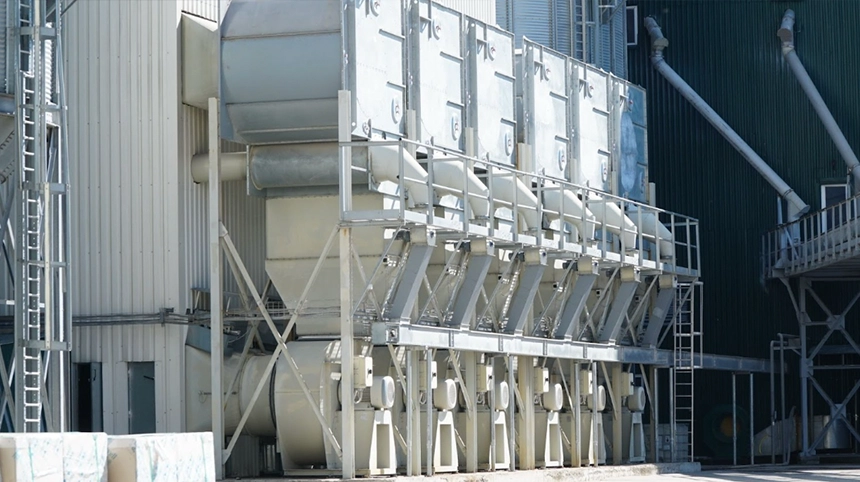Electrostatic Precipitators vs. Bag Filters: Which Is Best for Dust Control in Cement Plants?

Introduction
Cement production yields flue gas replete with high-temperature, high-concentration, and abrasive dust. This poses substantial challenges for cement plant dust control. And failing to meet stringent emission standards entails costly fines and production halts. Electrostatic precipitators (ESPs) and bag filters, both particulate filter types, emerge as leading solutions. Still, which excels for cement plant emissions? This article contrasts electrostatic precipitators and bag filters regarding principles, performance, and costs. It discloses why Guantong’s bag filter solutions prove superior for cement plants.
Working Principle Showdown
Electrostatic Precipitator (ESP)

What are electrostatic precipitators? Electrostatic precipitators constitute advanced electrostatic filters. They employ high-voltage electric fields to charge dust particles within flue gas. This draws them to grounded collection plates. Hence, particulate removal ensues. How does an electrostatic precipitator work? A corona discharge ionizes particles, enabling electrostatic attraction and collection.
- Mechanism: Charged dust is captured on plates and removed via mechanical rapping.
- Applications: Suitable for large-scale cement plants with high dust loads.
What do electrostatic precipitators do? They remove coarse dust from flue gas, achieving 85–92% efficiency but struggling with fine PM2.5 particles.
Bag Filters

Bag filters, a type of particulate filter, function akin to industrial vacuum cleaner bags. They physically ensnare dust upon the surface of fabric filter bags. This occurs within industrial process systems.
- Mechanism: Flue gas passes through porous bags, capturing dust while allowing clean gas to exit.
- Applications: This solution proves ideal for cement plants possessing diverse dust compositions. It excels at fine particle capture.
Bag filters furnish a mechanical approach to industrial dust control. They remain unswayed by dust properties, such as resistivity. Consequently, this ensures stable performance. Learn about Guantong’s bag filter technology for optimized cement plant emissions.
Performance Metrics Comparison
Dust Removal Efficiency
Bag filters surpass electrostatic precipitators when capturing fine particles, such as PM2.5. They attain over 99.5% efficiency. In contrast, ESPs typically yield 85–92%. This makes bag filters better suited to meet stringent cement plant emissions standards.
- Bag Filters: Capture >99.5% of PM2.5, ensuring compliance with limits like 10mg/Nm³.
- ESPs: Less effective for fine particles, often requiring additional particulate filters.
- Case Study: A 3,000-ton/day cement plant using Guantong’s bag filters reduced PM2.5 emissions to <5mg/Nm³, exceeding regulatory requirements.
Operating Condition Adaptability
Electrostatic filters rely heavily on dust resistivity. In cement production, variations in raw materials and fuels engender resistivity fluctuations. This triggers “back corona” in high-resistivity conditions. Such phenomena can diminish electrostatic precipitator efficiency by up to 30%. Still, conversely, bag filters, as particulate filters, remain impervious to resistivity. And this guarantees stable performance within industrial process systems.
- ESPs: Require precise tuning to manage resistivity changes.
- Bag Filters: Consistent across diverse dust types, ideal for cement plants.
- Example: A cement plant, contending with fluctuating coal quality, witnessed ESP efficiency dwindle to 70%. Conversely, Guantong’s bag filters sustained over 99% efficiency.
Cost and Maintenance
Electrostatic precipitators entail elevated initial costs. These surpass bag filters by 30–50%. Their high-voltage operation also commands substantial power consumption, nearing 5 kWh/ton of cement. Conversely, bag filters present reduced upfront expenditures. Upkeep primarily comprises filter bag replacement every 2–3 years, a task rendered simpler by process control engineering.
- ESPs: High energy and complex maintenance increase operational costs.
- Bag Filters: Simple bag replacement reduces costs.
- Case Study: A cement plant cut annual maintenance costs by 15%. This resulted from switching to Guantong’s bag filters. Moreover, this curtailed downtime within its emission control system.
Why Bag Filters Are the Better Choice for Cement Plants
Bag filters prove superior in cement plant dust control. They boast over 99.5% PM2.5 efficiency. Furthermore, they exhibit adaptability to varying dust conditions and offer cost-effective maintenance. Conversely, unlike electrostatic precipitators, they manage abrasive, high-temperature dust. This occurs without performance declines, thereby securing compliance with stringent emission control systems. Their simplicity and reliability make them the preferred choice for modern cement production.
Guantong’s Bag Filter Solutions
Guantong’s bag filter solutions cater to the cement industry’s high-temperature, abrasive dust challenges. They capitalize on instrumentation and control engineering.
High-Temperature Filter Media: Uses PTFE or Nomex materials to withstand 200–260°C, extending bag life by 20%.
- Optimized Airflow Distribution: Employs CFD to ensure uniform dust loading, reducing wear.
- Process Control Instruments: Instrumentation facilitates real-time monitoring. This ensures optimal performance. Crucially, process control and instrumentation underpin this support.
- Case Study: A 2,000-ton/day cement plant deployed Guantong’s bag filters. This attained dust emissions below 5mg/Nm³. It also yielded 25% lower maintenance costs. This exemplifies reliability in industrial process systems. What constitutes instrumentation? It entails employing advanced tools to optimize dust control efficiency. Guantong’s instrumentation and control systems attest to this.
Explore Guantong’s bag filter solutions for cement plant dust control.
Conclusion
Unreliable dust control can bottleneck cement production. Bag filters outstrip electrostatic precipitators concerning efficiency, adaptability, and cost for cement plant emissions. This guarantees compliance and operational stability. Guantong’s bespoke bag filters, fortified by process control and instrumentation engineering, furnish unparalleled particulate removal. Engage with Guantong to fashion an efficient, dependable bag filter solution for your cement plant’s industrial dust control needs. Learn more.
